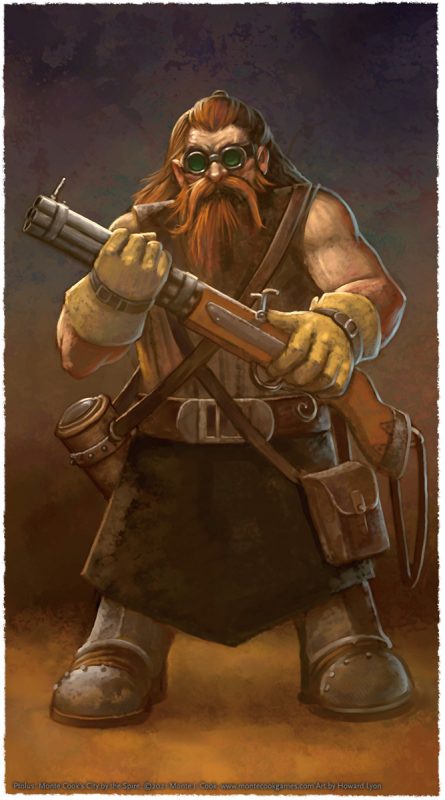The new Cypher System and 5e versions of Ptolus are now available in our shop! Making these two books wasn’t simply a matter of opening the original files, updating the rules information, and sending the revised files off to the printer—it took a lot of work and attention to detail, all with the dual intentions of preserving the feel of the original Ptolus and making sure that the new versions were as user-friendly as possible. This 2-part series is an under-the-hood and behind-the-scenes look at the challenges we faced, the solutions we came up with, and the steps we took to make these two new books a reality.
Adapting Ptolus from 3e to Cypher System and 5e was a complicated task. I could write an article or two just about how we converted the old layout files, pulled the text out of them, and synchronized the text of the two new books but for now, we’re just going to talk about the game design and development aspects of this process.
There’s a lot of pure creative design work Bruce Cordell and I—developers of these two versions of Ptolus—did for all of the system-specific stuff in each version of Ptolus; we’d either convert existing material or create something from scratch to replace something that had become obsolete. We converted the Ptolus-specific species like Shoal elves and litorians into Cypher System (CS) and 5e. Ptolus-specific monsters like the rhondintor got converted for both systems, as did the more complicated NPCs, and some 3e monsters (including trolls, various demons, and undead) were used often enough in the book that we gave them short CS write-ups in the monsters chapter to free up space in the CS callouts.

Bruce, who led CS development, took the 3e spells and made them into character abilities that PCs can learn. He also designed an entirely new CS system for potion and scroll versions of character abilities like Onslaught. I, leading 5e development, took the 3e spells and converted them to 5e spells. This sometimes involved major changes because 5e lets you power up a spell using a higher-level spell slot— fundamentally changing the starting spell slot level of some Ptolus spells. I also updated the 3e cleric domains to fit the new 5e format. Some 3e magic items were already in 5e, but needed CS versions, and some (like axiomatic weapons) needed to be converted for both systems.

We both took the Ptolus rules for firearms, made them work with the existing CS and 5e firearms rules, and kicked them up a notch so they’d still be a tempting but expensive option for fantasy PCs to use. Alignment was such a core part of 3e (and therefore 3e Ptolus) that we summarized the alignment system for the CS book so the various references to good, evil, lawful, and chaotic wouldn’t be left unexplained.
One of the most difficult 3e to 5e conversions was the Technology domain for clerics. In 3e, this domain had nine new spells: identify device (1st), lock and load (2nd), repair device (3rd), conjure device (4th), explosive shot (5th), heartseeking shot (6th), create device (7th), conveyance (8th), and cannons of heaven (9th). In 5e, cleric domains only go up to spell level 5, and there are two spells at each level, so that meant moving around a lot of these domain spells and changing their spell level, particularly to the high-level spells.
Five of them (identify device, lock and load, repair device, conjure device, and explosive shot) were able to stay at their same spell level, and with basically the same effect as the 3e version, using existing 5e spells as models for how they should convert.
Heartseeking shot went away in 5e; as a 3e spell meant to bypass physical Armor Class (AC) bonuses, it wasn’t really needed in 5e because AC doesn’t scale so high anymore (compare a 3e balor with AC 35 to a 5e balor with AC 19). Create device also went away because in 3e it was a long-duration version of conjure device, and in 5e we’re able to do that by casting conjure device using higher-level spell slots.
Conveyance changed from 8th level to 4th level so it could fill a spot on the domain spell list, and became an improved variant of fly (which it mostly was already). Cannons of heaven was a perfect example of a high-level 3e spell that was only high-level because its base damage was high; I changed it to a 4th-level spell so it could fill a spot on the domain spell list, and added in the option for increasing damage by using a higher-level spell slot (so an old-school Ptolus player who remembers cannons of heaven as a big-boom 9th-level attack spell feels happy using a 9th-level spell slot for it to inflict 9d10 points of damage).
Finally, I filled in the remaining open slots on the domain spell list with thematically-appropriate 5e spells (unseen servant, find traps, and animate objects).
And on top of all the spell changes, the 5e domain needed bonus proficiencies, new uses for channel divinity, and a couple of new domain abilities. Phew! Meanwhile, for the CS version, Bruce converted all nine of those 3e Technology domain spells to character abilities in the Cypher System.
That is just one of the hundreds of rules-specific decisions we made throughout the books. In the second part of this series, I’ll get into how we converted the Inverted Pyramid prestige class, a 3e special advanced class that has no true parallel in 5e…until now.
Be sure to check back on Thursday for part 2!